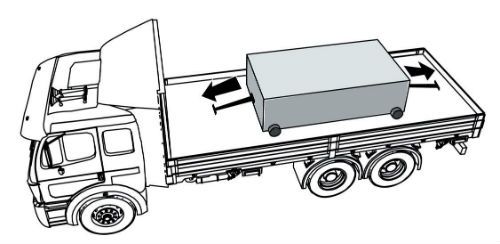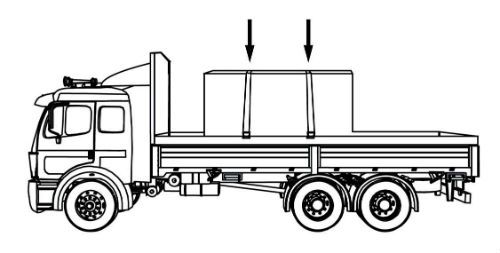CDL Practice Tests: Flatbed Cargo Securement
Choose A Section:
Go!When loaded cement pipe over 45 inches in diameter, which pipes should be blocked, wedged, or otherwise immobilized?
- Front and rear.
- It depends on the weight of the load.
- Rear only.
- Front only.
Immobilize the front and rear pipe with on of the following methods:
- Blocking
- Wedges
- Vehicle end structure
- Stakes
- Locked pipe unloader
- Other equivalent means
A dunnage bag is:
- A waterproof sheet used to cover cargo.
- A structure, device, or another substantial article placed against or around an article to prevent horizontal movement of the article.
- An inflatable bag intended to fill otherwise empty space between articles of cargo, or between articles of cargo and the wall of the vehicle.
- A transverse load bearing structural component, particularly a part of a log bunk.
Dunnage bag:
An inflatable bag intended to fill otherwise empty space between articles of cargo, or between articles of cargo and the wall of the vehicle.
If you were instructed to 'tarp' a load, what would you be using?
- A strip of material that may be used to unitize articles and is tensioned and clamped or crimped back upon itself.
- A platform or tray on which cargo is placed so that it can be handled as an article.
- A short piece of material, usually wood, nailed to the deck to reinforce blocking.
- A waterproof sheet used to cover cargo.
Tarp:
A waterproof sheet used to cover cargo.
What is the minimum WLL of each tiedown used to secure crushed or flattened vehicles?
- 10,000 lbs
- 2,268 lbs
- It depends on the vehicle
- 5,000 lbs
Option 2:
Has containment walls on three sides that:
- Extend to the full height of the load
- Block against cargo movement in the forward, rearward, and one sideways direction.
Secures each stack of vehicles with a minimum of two tiedowns, each having a minimum WLL of 2,268 kg (5,000 lb.).
Option 3:
Has containment walls on two sides that:
- Extend to the full height of the load.
- Block against cargo movement in the forward and rearward.
Secures each stack of vehicles with a minimum of three tiedowns, each having a minimum WLL of 2,268 kg (5,000 lb.).
Option 4:
Has a minimum of four tiedowns per vehicle stack with each tiedown having a minimum WLL of 2,268 kg (5,000 lb.).
All of these are requirements for securing longwood lengthwise except:
- Each outside log should bear against at least two stakes, one near each end of the log.
- Each end of the log should extend at least 3 inches beyond the stakes.
- Must be cradled in two or more bunks or contained by stakes.
- Secure each log with at least two tiedowns if shorter logs are carried on top of the stack.
Requirements for securing longwood loaded lengthwise
- Longwood must be cradled in two or more bunks or contained by stakes.
- Each outside log should bear against at least two stakes, one near each end of the log.
- Each end of the log should extend at least 0.15 m (6 in) beyond the stakes.
- If shorter logs are carried on top of the stack, secure each log with at least two tiedowns.
As part of their pre-trip cargo securement inspection, drivers should:
- Check for anything that will obscure their vision.
- Make sure cargo is properly secured.
- Inform carrier of any inadequate packaging.
- All of these apply.
Driver inspection checklist:
Pre-Trip
- Make sure that cargo is properly distributed and adequately secured (in other words, according to the Standard).
- Make sure that all securement equipment and vehicle structures are in good working order and used consistent with their capability.
- Stow vehicle equipment.
- Make sure that nothing obscures front and side views or interferes with the ability to drive the vehicle or respond in an emergency.
-
Inform carrier if packaging is not adequate. For example:
- Banding is loose or not symmetrical on package.
- Banding attachment device(s) are inefficient.
- Wrapping is broken or ineffective.
- Pallets are broken.
What is the minimum WLL of a tiedown used to secure logs?
- 1,800 lb
- 4,000 lb
- 50% of cargo weight
- It depends on if you are hauling shortwood or longwood
- Use tiedowns in combination with bunks, stakes, or standards and bolsters to secure the load.
- All tiedowns must have a working load limit not less than 1,800 kg (4,000 lb.).
- Tension tiedowns as tightly as possible but not beyond their working load limit.
Load securement for cargo weighing 29,650 lbs must be able to withstand upward force of how many lbs?
- 30,000 lbs
- 29,650 lbs
- 5,930 lbs
- 14,825 lbs
How strong must the vehicle structure and anchor points be?
All elements of the vehicle structure and anchor points must be strong enough to withstand the forces described on page 7.
- Forward force: 0.8 g (80%)
- Rearward force: 0.5.g (50%)
- Sideways force: 0.5 g (50%)
- Upward force: 0.2 g (20%)
Which of these are requirements for securement systems?
- There should be no knots in the tiedowns.
- These all qualify as requirements.
- If a tiedown would be subject to cutting or abrasion, edge protection should be used.
- Components should be in proper working order.
Requirements for Securement System:
- In proper working order with no damaged or weakened components that affect their performance or reduce their working load limit.
- No knots.
- Attached and secured in a manner that prevents them from coming loose during transit.
- Able to be tightened by a driver of an in-transit vehicle.
- Located inboard of rub rails whenever practicable.
- Edge protection must be used when a tiedown would be subject to abrasion or cutting.
The aggregate WLL for logs loaded lengthwise must be at least:
- 1/2 the weight of the load.
- 4,000 lbs
- 1/2 the weight of the stack.
- 1/6 the weight of the stack.
Working load limit for longwood and shortwood loaded lengthwise
The aggregate working load limit for all tiedowns must be no less than 1/6 the weight of the stack of logs.
Note: This requirement is much less than the general requirement of an aggregate working load limit equal to 1/2 the weight of the load. This lowered requirement recognizes that the bunks/stakes help to prevent slippage.
About The Flatbed Cargo Securement CDL Manual
Studying the flatbed cargo securement CDL manual is not a requirement for getting your CDL permit or license. It is required knowledge for flatbed drivers.
Some questions you should be able to answer for flatbed cargo securement:
- What is the minimum Working Load Limit of a tiedown used to secure logs?
- What is the minimum weight of a shipment of paper rolls that would require specific securement requirements?
- When securing concrete pipe over 45 inches loaded crosswise, which direction must the tiedowns on the front half of the load run?
- What is a cab shield?
- When securing concrete pipe over 45 inches loaded crosswise, which direction must the tiedowns on the rear half of the load run?
- What is a dunnage bag?
- Who is responsible for inspecting securing devices and cargo within the first 50 miles?
- How many tiedowns are required on a stack of shortwood loaded crosswise?
- What is the minimum working load limit of each tiedown used to secure crushed or flattened vehicles?
- Define 'bolster'
- What is a hook-lift container?
- When a tiedown is attached directly to the cargo, what is the ideal angle where it attached to the vehicle?
What is a securing device?
Any device specifically manufactured to attach or secure cargo to a vehicle or trailer:
- Synthetic Webbing
- Chain
- Wire rope
- Manila rope
- Synthetic rope
- Steel strapping
- Clamps and latches
- Blocking
- Front-end structure
- Grab hooks
- Binders
- Shackles
- Winches
- Stake pockets
- D-rings
- Webbing ratchet
- Bracing
- Friction mat
What is a tiedown?
A combination of securing devices that forms an assembly that:
- Attaches cargo to, or restrains cargo on a vehicle.
- Is attached to anchor point(s).

Some tiedowns are attached to the cargo and provide direct resistance to restrain the cargo from movement.

Some tie-downs pass over or through the cargo. They create a downward force that increases the effect of friction between the cargo and the deck. This friction restrains the cargo.
 Related Cargo Securement Terms That Every Driver Should Know:
Related Cargo Securement Terms That Every Driver Should Know:
-
Tiedown:
A combination of securing devices which form an assembly that attaches cargo to, or restrains cargo on, a vehicle or trailer, and is attached to anchor point(s).
-
Contained:
Cargo is contained if it fills a sided vehicle, and every article is in contact with or sufficiently close to a wall or other articles so that it cannot shift or tip if those other articles are also unable to shift or tip.
-
Blocking:
A structure, device, or another substantial article placed against or around an article to prevent horizontal movement of the article.
How should tiedowns be attached?
Tiedowns can be used in two ways:
-
Attached to the cargo:
- Tiedowns attached to the vehicle and attached to the cargo.
- Tiedowns attached to the vehicle, pass through or aroundan article of cargo, and then are attached to the vehicle again.
-
Pass over the cargo:
- Tiedowns attached to the vehicle, passed over the cargo, and then attached to the vehicle again.
Tiedown placement:

Place the tiedown as close as possible to the spacer.
Position the tiedowns as symetrically as possible over the length of the article.

Position the tiedowns to preserve the integrity of the article.







 TT On Facebook
TT On Facebook